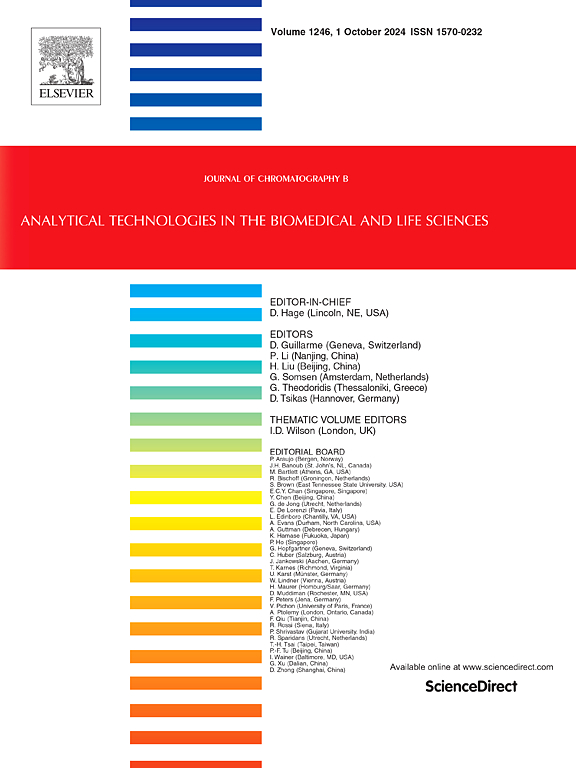使用天然深共晶溶剂的注射器内聚丙烯纤维支撑液体微萃取,用于生物和环境样品中苯丙胺类兴奋剂的便捷分析
IF 2.8
3区 医学
Q2 BIOCHEMICAL RESEARCH METHODS
引用次数: 0
摘要
本研究介绍了一种环保高效的样品制备方法,用于生物和环境样品中苯丙胺类兴奋剂(ATS)的提取和分析。所提出的聚丙烯纤维支撑的液相微萃取(PPF- slme)方法利用PPF作为支撑介质,天然深共晶溶剂(NADES)作为萃取剂,配合简单的注射器形式进行流线型的萃取和解吸过程。使用来自一次性三层非织造口罩的纯PPF,为传统天然纤维提供了一种具有成本效益和可持续性的替代品。此外,由天然和环保成分组成的NADES增强了该方法的整体可持续性。这种方法减少了溶剂的消耗,同时提高了提取效率,使其成为传统方法的绿色替代品。系统评价了优化后的提取条件,包括NADES的组成、溶剂体积和拉推循环次数。该方法在0.01 ~ 10 ng/mL的浓度范围内具有良好的线性关系,R2大于0.994,检出限为1 ~ 6 ng/L。相对回收率为81.8% ~ 104.8%,相对标准偏差小于10.6%。该方法的性能在环境和生物样品分析中都得到了成功的证明,为ATS检测提供了快速、经济、敏感和可持续的解决方案。本文章由计算机程序翻译,如有差异,请以英文原文为准。
In-syringe polypropylene fiber-supported liquid microextraction using natural deep eutectic solvents for the convenient analysis of amphetamine-type stimulants in biological and environmental samples
This study introduces an environmentally friendly and efficient sample preparation method for the extraction and analysis of amphetamine-type stimulants (ATS) in biological and environmental samples. The proposed polypropylene fiber-supported liquid-phase microextraction (PPF-SLME) method utilizes PPF as the support medium and natural deep eutectic solvents (NADES) as the extractant, coupled with a simple in-syringe format for streamlined extraction and desorption processes. The use of pure PPF, sourced from disposable three-layer nonwoven face masks, offers a cost-effective and sustainable alternative to conventional natural fibers. Additionally, NADES, composed of natural and environmentally benign components, enhances the overall sustainability of the method. This approach reduces solvent consumption while improving extraction efficiency, making it a green alternative to traditional methods. The optimized extraction conditions—including NADES composition, solvent volumes, and the number of pull-push cycles—were systematically evaluated. The method exhibited robust linearity within the concentration range of 0.01–10 ng/mL, featuring an R2 value greater than 0.994, and detection limits spanning from 1 to 6 ng/L. Relative recoveries ranged from 81.8% to 104.8%, with relative standard deviations below 10.6%. The method's performance was successfully demonstrated in both environmental and biological sample analyses, providing a rapid, cost-effective, sensitive, and sustainable solution for ATS detection.
求助全文
通过发布文献求助,成功后即可免费获取论文全文。
去求助
来源期刊

Journal of Chromatography B
医学-分析化学
CiteScore
5.60
自引率
3.30%
发文量
306
审稿时长
44 days
期刊介绍:
The Journal of Chromatography B publishes papers on developments in separation science relevant to biology and biomedical research including both fundamental advances and applications. Analytical techniques which may be considered include the various facets of chromatography, electrophoresis and related methods, affinity and immunoaffinity-based methodologies, hyphenated and other multi-dimensional techniques, and microanalytical approaches. The journal also considers articles reporting developments in sample preparation, detection techniques including mass spectrometry, and data handling and analysis.
Developments related to preparative separations for the isolation and purification of components of biological systems may be published, including chromatographic and electrophoretic methods, affinity separations, field flow fractionation and other preparative approaches.
Applications to the analysis of biological systems and samples will be considered when the analytical science contains a significant element of novelty, e.g. a new approach to the separation of a compound, novel combination of analytical techniques, or significantly improved analytical performance.
 求助内容:
求助内容: 应助结果提醒方式:
应助结果提醒方式:


